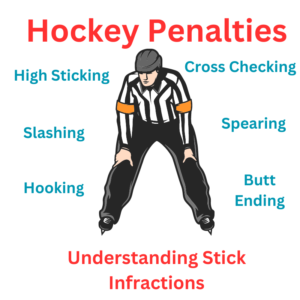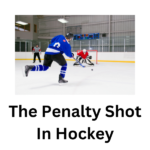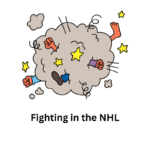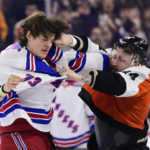Hockey is an exhilarating sport that combines skill, speed, and physicality. However, amidst the excitement of the game, there are rules and regulations in place to ensure fair play and safety for all players involved. Stick infractions are among the most common penalties in hockey, and understanding them is crucial for players and fans alike. In this guide, we’ll break down the six main stick infractions outlined in the NHL rule book, explaining each in simple terms.

Butt Ending:
Butt-ending occurs when a player jabs an opponent with the knob of their stick. This action is extremely dangerous and can cause serious injury. Players should never use the butt end of their stick to make contact with an opponent, and referees are quick to penalize this infraction with a major penalty and possible ejection from the game.
Cross Checking:
Cross-checking happens when a player uses the shaft of their stick to forcefully push or hit an opponent. This is often done with both hands on the stick and can result in significant impact to the opposing player’s body. Cross-checking is not only against the rules but also poses a risk of injury, especially when the player being checked is caught off guard or unprepared.
High Sticking:
High sticking occurs when a player’s stick makes contact with an opponent above the shoulders. This can happen accidentally, such as when a player follows through on a shot or pass, or intentionally, when a player raises their stick in a reckless manner. High sticking penalties can vary depending on the severity of the contact, ranging from minor infractions to double-minors or major penalties if blood is drawn.
Hooking:
Hooking is when a player uses their stick to impede the progress of an opponent by hooking it around their body or stick. This can happen when a player is trying to gain an advantage defensively but is deemed illegal because it interferes with the opponent’s ability to skate or maneuver freely. Referees will penalize hooking with a two minute minor penalty.
Slashing:
Slashing occurs when a player swings their stick with force at an opponent, making contact with any part of their body or stick. This can be a dangerous play, especially if the slash lands on unprotected areas like the hands or wrists. Slashing penalties are typically called as minor infractions, but repeated offenses or particularly egregious slashes can result in more severe punishment.
Spearing:
Spearing is perhaps the most dangerous stick infraction in hockey. It involves jabbing an opponent with the blade of the stick, which can cause severe injury, particularly to the abdominal area. Spearing is strictly prohibited and is met with major penalties and possible ejection from the game. Players must exercise caution and respect for their opponents to avoid engaging in such reckless behavior.
In conclusion, stick infractions are serious offenses in hockey that can result in penalties, injuries, and consequences for both the player and their team. Whether it’s a momentary lapse in judgment resulting in a minor penalty or a more severe infraction leading to a major penalty and possible ejection, each penalty can shift the momentum of a game and put the penalized team at a disadvantage.
Understanding the rules and regulations regarding stick play is essential for promoting fair competition and maintaining the safety of all participants on the ice. Whether you’re a player, coach, or fan, it’s important to recognize and respect these rules to ensure an enjoyable and safe hockey experience for everyone involved.
Thanks for your time. Please leave comments and suggestions below.




